Introduction
Updated 11/7/2011: Added USB 3.0 info
Updated 9/29/2011: Corrections in Synology information
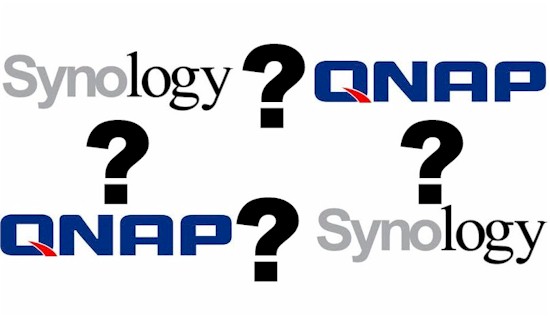
Browse through the SNB NAS, QNAP and Synology Forums and you’ll find many, many posts asking for help in deciding between two similar models from these two popular NAS vendors. You can dig through specs, research forums and user reviews until your eyes bleed and post dozens of "which should I buy" queries around the net. In the end, the final choice has to be yours.
In an effort to either make the choice easier, or maybe harder for those ultra-analyticals among us, I asked each company to make its case for why you should buy from them instead of the other. Both responded, but with varying levels of detail. In some cases, I was asked to not quote responses directly, so I’ve paraphrased. Before we get into the responses, let’s first look at some general information on the consumer NAS market.
The Big Picture
In general, consumers don’t buy that many NASes. In-Stat’s Worldwide Consumer Network-Attached Storage: Low Penetration, High Growth report (May 2011) [executive summary with specifics redacted] states "estimated household penetration of consumer NAS in North America will be 4.4% [emphasis mine] at year-end 2015[emphasis mine]".
Given the low average selling prices of consumer NASes, the report says that "worldwide revenues for consumer NAS were approximately $678.4 M [emphasis mine] in 2010". So compared to a total $5 billion external storage market in 1Q2010 (source IDC), consumer NAS is very small potatoes.
So it’s understandable that NAS manufacturers are looking to small to medium businesses for real revenue growth. This is why you’re seeing products like QNAP’s recently-released Intel multicore-based eight and 12 bay 2U rackmount NASes, NETGEAR’s ReadyNAS 3200 and 4200, Thecus’ Core i3 based N8900 and Synology’s RackStation and Deskstation.
For "big iron" enterprise-grade NASes, the IDC report linked above lists the top companies by revenue as EMC, IBM, NetApp, HP and Dell.
For consumer NAS, the In-Stat report linked above says Buffalo leads the consumer NAS market in terms of units shipped. But this Infonetics release from June 2011 says that NETGEAR led the worldwide NAS appliance market in 2009 "by a wide margin", but QNAP pulled even with NETGEAR in 2010. The release doesn’t say what measure of market share was used, though.
A last look at market share is available in the In-Stat table shown below, which I found posted in this Origin Storage article, which probably came from the In-Stat’s Worldwide Consumer Network-Attached Storage: Low Penetration, High Growth report.
It shows Buffalo #1 in terms of units shipped, with NETGEAR in fifth place, but with neither QNAP nor Thecus in the top 11. (Thecus is outlined from the Original Storage article, not from the In-Stat report).
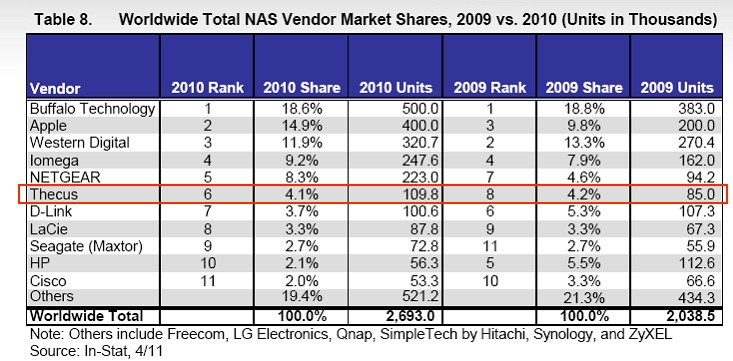
So this would seem to contradict the claim that QNAP and NETGEAR are neck-and-neck in leading the consumer NAS market. It seems to be clear, however, that between QNAP and Synology, the latter has a smaller share of the market. Note that In-Stat’s data shows Apple as #2 in NAS market share in terms of units sold, with only one product (the Time Capsule)!
Updated 9/29/2011
Synology had this to say about its absence from market share reports:
We’re not included in the In-Stat report because we don’t report any type of numbers to analysts. Most of our competitors are public firms (or owned by conglomerates) and these numbers are public domain, we choose to keep our sales numbers close to the chest. We also turn down offers to OEM our products for larger companies, which leads to inflated numbers for those that do so.
Strengths and Focus
Both companies said they weren’t interested in getting into detailed feature-by-feature comparisons. So if that’s what you are looking for, you can bail out now. But they were happy to talk about their core strengths and company direction. This is more valuable than you may think, because it helps you understand each company’s mindset.
In my former life as a test equipment engineer, the company I worked for set reliability as Job #1. This was drilled into my head from the day I joined the company until the marching orders changed years later, in response to a changing market. It formed many design decisions, which in turn set key aspects of products we designed. So understanding what a company values will help you understand the products it makes.
Synology said its primary focus is on improving the overall NAS user experience. This includes performance, features and support with equal importance on each. Support is done in-house by teams in Synology’s US, Taiwan, UK, and Germany offices. All products have at least a 2 year warranty with 3 years for "+" series products.
Synology also believes it led the market with the first AJAX based DiskStation Manager admin GUI and that its "desktop" model will be adopted by other manufacturers.
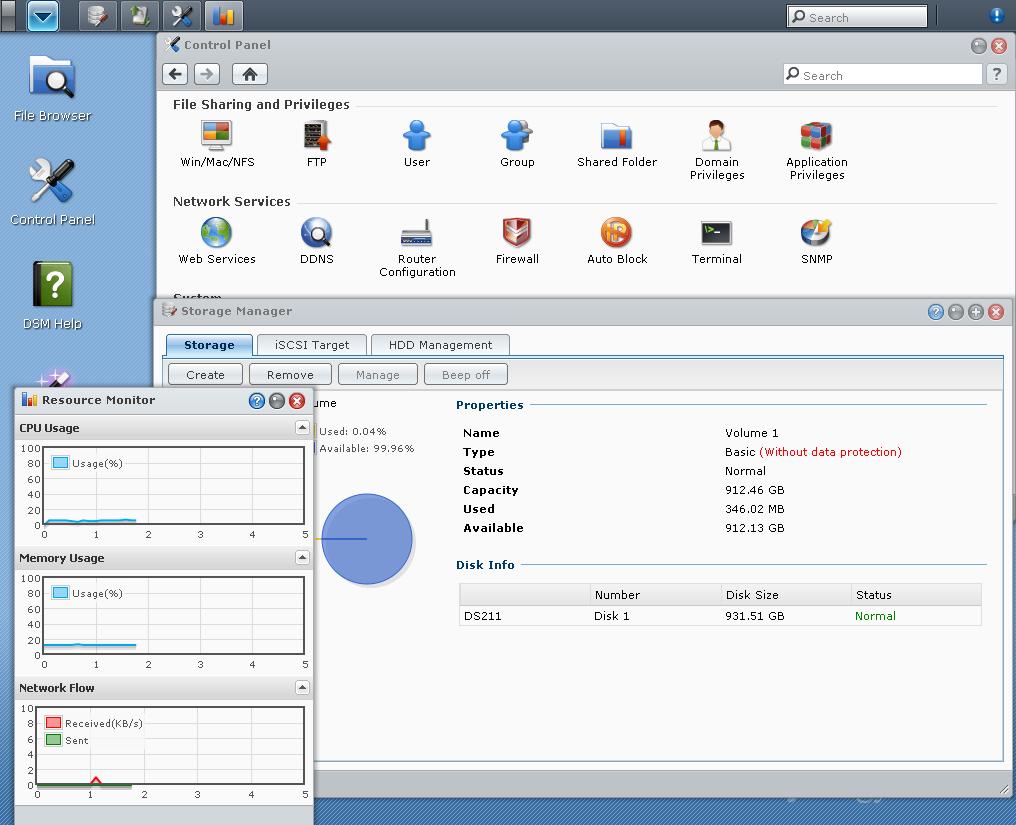
Synology Disk Station Manager User Interface
I’ve included screenshots of each OS so you can judge for yourself.
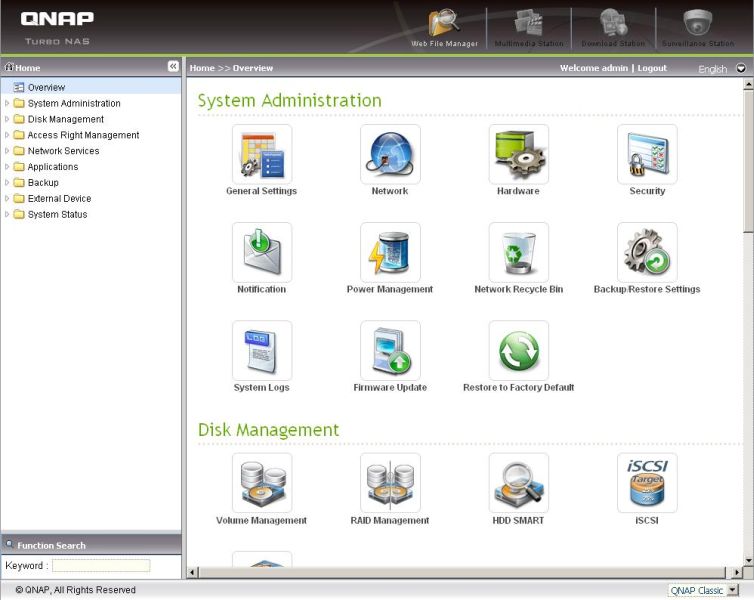
QNAP V3 OS User Interface
For those looking for more quantitative differences, Synology noted that it is the only NAS manufacturer to offer expandable NASes that connect to expansion units via high-bandwidth dedicated interfaces.
QNAP‘s primary focus is clearly on business users with a specific focus on virtualization. It is definitely after a chunk of the business now enjoyed by much higher priced products from NetApp, HP and Dell and to some extent, Drobo. To support this focus, QNAP has more models with hot-swappable bays (even single-drive models), LCD status screens and USB 3.0 ports and supports 6 Gb/s SATA on some high-end models.
QNAP was more specific in its responses than Synology. It said it believes its iSCSI implementation is more stable and flexible with features such as multiple LUNs and targets, flexible LUN mapping and LUN masking. QNAP’s iSCSI implementation includes iSCSI initiator ("VDD") support that enables SAN-like capability. It also pointed to its Real Time Remote Replication (RTRR) feature (" 7-10x faster than rsync") as a key advantage for enhanced security through faster and more frequent backups.
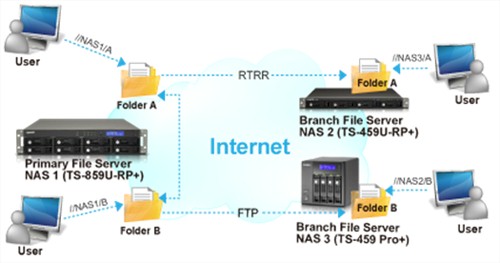
QNAP Real Time Remote Replication
My Take
If you’re considering Synology or QNAP products, let’s face it, you’re not looking for the cheapest NAS. Your personal decision tree has brought you to weigh premium-priced NASes that pack a lot of features into a NAS OS that is available in a wide array of hardware platforms with different combinations of CPU, RAM, internal storage bays and external storage ports.
The good news is that with either vendor, you generally don’t have to choose a specific model to get a specific feature. Model choice can be made on the basis of how much performance you want, how many bays you need, how many LAN ports you want and whether you want eSATA or USB 3.0 ports for external drive attachment.
Many of the "which NAS" forum posts ask whether Synology or QNAP NASes are better for streaming and remote multimedia access. Synology didn’t mention this topic at all in its response, but QNAP provided some specifics and I have my own observations.
Updated 9/29/2011
Both companies use PacketVideo’s TwonkyMedia server as the heart of their UPnP/ DLNA media serving. QNAP uses PacketVideo’s TwonkyMedia server as the heart of its UPnP/ DLNA media serving, while Synology has written its own custom media server. Both also support iTunes serving.
QNAP lets you directly access the TwonkyMedia server admin, while Synology does not. But only a few features are exposed in the direct TwonkyMedia interface and transcoding isn’t among them. Video transcoding is not supported by either company, but Synology exposes enables for FLAC/APE, AAC, OGG and AIFF audio transcoding.
To find out how well either company supports specific media players, you’ll need to dig into its forum to see how others have fared. In all, I don’t get the sense that either QNAP or Synology have an edge in media streaming / serving. And given both companies’ focus on capturing more small-to-medium business buyers, I don’t think this is a priority for either.
For remote / mobile media access, both companies have browser-based access for files, audio and photos and iOS and Android apps available for remote file, music and photo access. QNAP’s browser-based player and iOS and Android apps also support video playback, but do not transcode. Synology supports video playback through its DS photo+ feature.
If you need on-the-fly transcoding, you might want to look at NETGEAR ReadyNASes, which offer Orb and Skifta to support remote media playback. But NASes generally don’t have the horsepower for real-time high-def transcoding. So don’t be fooled into thinking that anyone’s product is going to make any video format you have playable on every device.
The two competitors take different approaches to storage expansion. QNAP supports the more traditional manual online RAID capacity expansion and RAID level migration while Synology takes an approach more similar to NETGEAR’s X-RAID2 with some shades of Drobo mixed in.
Synology’s Hybrid RAID (SHR) is an automatic RAID management system "designed to meet the needs for those users who do not care or do not want to know what are the finer aspects of the various RAID-levels". The diagam below shows that SHR can provide more usable storage than standard RAID when different drive sizes are used.

Synology Hybrid RAID vs. standard RAID
For expanding storage beyond the box, QNAP’s products support an iSCSI initiator to build simple SANs by attaching to iSCSI targets. Synology takes a different approach by offering some models with expansion cabinets connected by either eSATA or Infiniband cables. Synology’s approach appeals to those who aren’t quite sure of their future storage needs and don’t mind paying more now for the flexibility to add (a lot) more drives later.
One of the reasons you pay more for QNAP and Synology products is that you get more features. And in addition to stock features, both products also let you add more bells and whistles via installable apps. QNAP makes this a bit easier than Synology by providing a pop-up pick list of "QPKG" apps that can be downloaded to your computer with a click, then installed via the QNAP GUI. But on the downside, QNAP doesn’t differentiate between apps it has tested and untested third-party apps. You can also go to QNAP’s QPKG page to download apps.
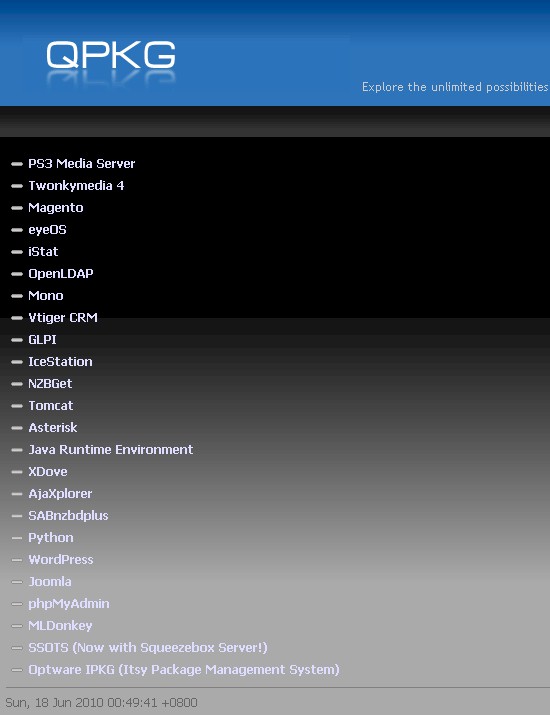
QNAP QPKG list
Updated 9/29/2011
Synology doesn’t provide a link to its DSM Packages download page from its GUI Package Management screen. But it does separate its apps into "quick install" apps that are "packed and tested by Synology" and 3rd party apps that are just "selected and tested".
Synology added its Package Center in DSM 3.2 that provides app browsing and installation directly from the DSM desktop.
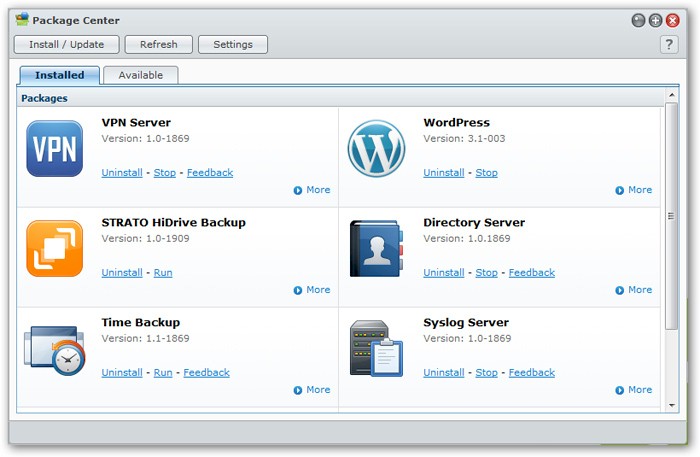
Synology Package Center
Synology also groups apps by type on its DSM Packages download page, i.e. Blog System, Bulletin Board, Content Management, Customer Relationship Management, Database Management, E-Commerce, E-Learning, Gallery, Ticket System and Wiki & Groupware. The full list of "verified" Synology DSM packages totals 46 vs. QNAP’s total list of 28.
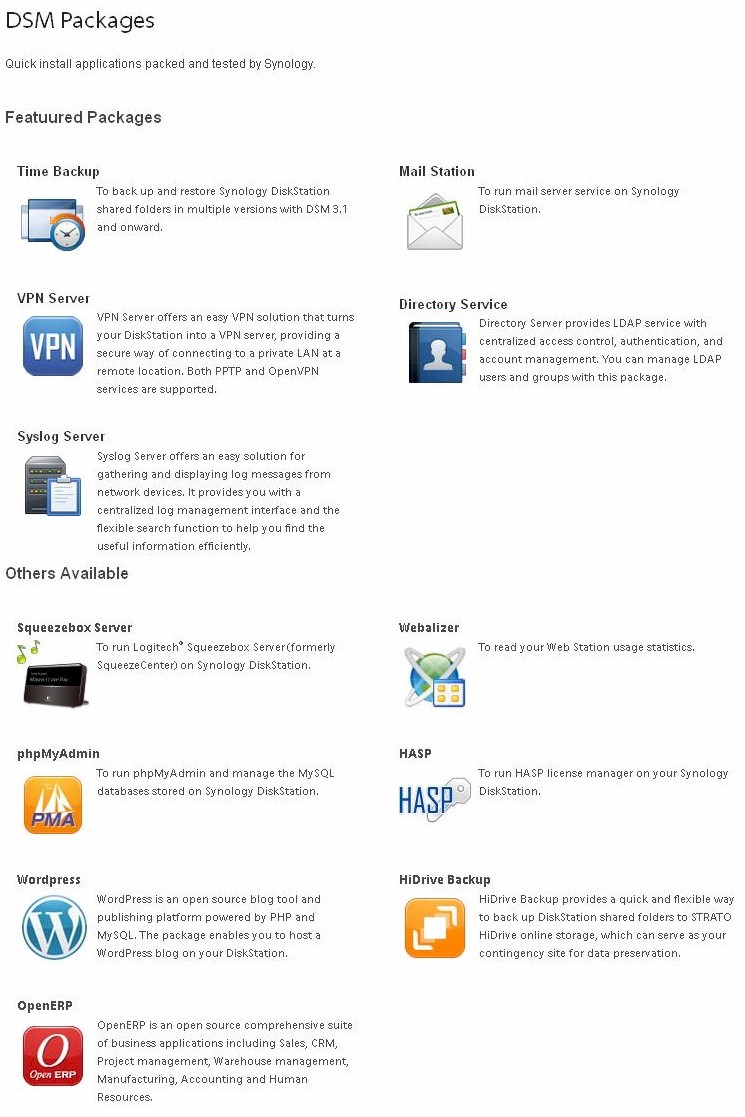
Synology DSM Quick Install Packages
Both vendors support the biggies like Squeezebox Server, WordPress, phpMyAdmin, Joomla and Drupal. But Synology has apps adding Syslog, VPN and LDAP servers as well as phpBB and SugarCRM. In contrast, QNAP’s offerings lean more toward downloaders including MLDonkey, SABnzbdplus, Transmission and pyLoad.
And so that I don’t forget, both QNAP and Synology products allow full root access via Telnet and SSH and can support full LAMP webserving.
The last key difference is in backup, where QNAP maintains an edge. QNAP is about 3X faster than Synology when backing up to an NTFS-formatted eSATA drive due to its use of Paragon’s NTFS driver. QNAP also has three models with USB 3.0 ports as I write this, while Synology has none.
Updated 9/29/2011: USB 3.0 info
Synology recently added two models with USB 3.0 ports: the DS212 and DS212+.
Both vendors support scheduled and immediate backups to attached or networked rsync targets, cloud backup to Amazon S3 and Apple Time Machine backups (including Mac OS Lion). But QNAP has recently added a Real Time Remote Replication feature that also works with attached drives and FTP servers in addition to other QNAP NASes. I also like that QNAP logs both start and stop of network backup sessions in its web interface while Synology logs only the start.
Neither company, however, yet has the flexibility of NETGEAR ReadyNASes, which support backup to and from SMB shares, FTP servers as well as rsync servers.
Closing Thoughts
In the end, both QNAP and Synology have broad product lines with many features that can be expanded in storage and function. QNAP definitely has more models than Synology, but I don’t necessarily view that as an advantage. Buyers can spend more time than they should trying to figure out whether an extra $20 to $50 is worth it for a bit more performance. I’d like to see QNAP be more aggressive in retiring previous-generation products when it introduces models that are, for all intents and purposes, replacements for them.
As I said earlier, if you must have a specific feature, you still need to dig into spec tables and troll forums to be really, really sure that it’s there and works. But I hope this higher-level view has helped clear at least some of the general Synology / QNAP, QNAP / Synology fog from your brain.
